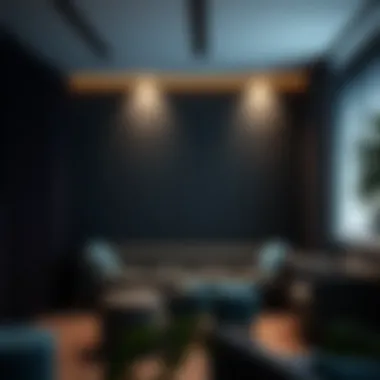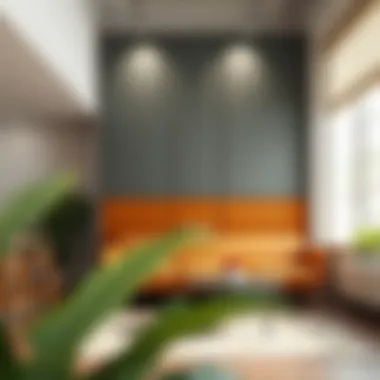Temporary Soundproof Walls: Advantages and Applications


Intro
In today's world, noise is often an unwelcome companion. From the rhythmic sounds of city traffic to the lively chatter of neighbors, unwanted noise can intrude into our personal spaces, disrupting our peace. Temporary soundproof walls offer a practical solution for those looking to carve out a quieter sanctuary, whether at home or in a commercial setting. In this guide, we'll explore the ins and outs of these portable barriers, including the materials used, their construction, and the significant advantages they provide.
The concept of soundproof walls isn't a recent one. However, the idea of making them temporary and versatile is gaining traction among homeowners, designers, and DIY enthusiasts alike. By understanding how to effectively implement these barriers, readers can make informed choices that cater to their specific soundproofing needs.
In the sections to follow, we will delve deeper into the benefits of temporary soundproof walls, the materials and techniques available, and practical guidance for installation. Our aim is to equip you with the knowledge needed to create a more tranquil environment, regardless of whether you're a seasoned DIYer or simply venturing into the world of home improvement. Let’s embark on this journey towards quieter living spaces.
Understanding Temporary Soundproof Walls
Temporary soundproof walls serve several essential functions, particularly in our increasingly noisy world. As homeowners and professionals alike recognize the growing importance of acoustics, temporary soundproofing solutions provide a flexible and effective way to manage sound levels without committing to permanent changes. Households dealing with noisy neighbors, contractors needing to optimize quiet during key hours, or businesses wishing to create private spaces will find these structures invaluable.
The very nature of temporary soundproof walls implies adaptability. This aspect is crucial for varied environments, such as homes, offices, or events where noise distractions can interfere with daily activities or productivity.
Their purpose stretches beyond mere noise reduction; these walls also create a sense of privacy and comfort. By tackling sound interference, they contribute significantly to improving overall well-being and concentration, factors often overlooked until one finds themself amidst distractions.
Definition and Purpose
Temporary soundproof walls are structures designed to minimize noise from entering or exiting a space. Unlike traditional soundproofing installations, which require significant modifications, these walls are usually lightweight and movable. Constructed from various materials such as acoustic panels, foam, or specialized vinyl, they can be set up and taken down with relative ease. Their primary function is to create a barrier against unwanted noise, which can be particularly useful in shared living spaces or densely populated areas.
These walls can serve multiple purposes. For instance, in a residential setting, they might block sound from a busy street or reduce noise between rooms during family gatherings. In commercial applications, they could facilitate focused work environments by creating quiet zones. The flexibility these structures offer allows users to adapt their sound environments quickly and efficiently, maintaining comfort and productivity.
The Importance of Soundproofing
Soundproofing isn't just about silence; it's about the quality of living and working. The stress caused by noise pollution is more than just an inconvenience; it can hinder sleep, concentration, and overall mental health. In fact, research suggests that consistent exposure to loud sounds may lead to long-term health issues such as hearing loss or increased anxiety levels.
In the realm of design and architecture, soundproofing considerations have increasingly taken center stage. With urban environments expanding and populations becoming denser, strategies to control acoustics have a significant impact. Temporary soundproof walls offer a pragmatic solution: they can be implemented quickly, are often cost-effective, and allow for changes based on dynamic needs. This adaptability enhances their relevance in various settings, making them an indispensable tool in today’s noise-conscious world.
"In every busy city, the silent spaces are like hidden treasures. Soundproofing can help uncover these hidden gems of tranquility in hectic surroundings."
As we delve deeper into temporary soundproof walls, understanding these concepts sets the foundation for discussing materials, installation methods, and practical applications. This foundation lays the groundwork for appreciating not just the walls themselves, but the vital role they play in creating enjoyable environments.
Materials Used in Soundproof Walls
When it comes to constructing temporary soundproof walls, the materials used play a significant role in determining their effectiveness. Different materials exhibit varied capabilities to absorb, block, or reflect sound, and knowing which to use can make all the difference between a peaceful retreat and a noisy disturbance. Selecting the right materials not only enhances the soundproofing but can also influence aesthetic appeal and overall functionality.
Soundproofing is particularly important in multi-use environments where noise levels can fluctuate due to various activities. By employing appropriate materials, one can create an oasis within bustling settings, thus transforming the ambiance of a space. Here, we delve into the key materials often used in soundproof wall construction and their unique benefits.
Acoustic Panels
Acoustic panels have emerged as go-to solutions for many seeking to dampen sound in a temporary setup. These panels are typically made from dense materials that absorb sound waves, thus preventing them from bouncing off walls.
Some common materials for acoustic panels include fiberglass, foam, and fabric-wrapped versions. The installation of these panels is pretty straightforward—either by mounting them onto existing walls or using temporary frames. Their versatility is a game changer due to the range of styles and colors available, allowing homeowners and designers to maintain aesthetic preferences while combating noise.
- Benefits:
- Effective in reducing echoes and improving sound quality within a space.
- Available in various designs to suit different decor styles.
- Easy to install and reposition as needed.
Mass Loaded Vinyl
Another gems in the world of soundproofing is Mass Loaded Vinyl (MLV). This product is a heavy, flexible material designed specifically to block sound transmission. Its mass is crucial—heavier materials tend to block more sound.
MLV can be applied directly to surfaces, or used to create barriers within walls, giving it a dual purpose that’s hard to beat. It’s especially effective in situations where noise insulation is paramount. The only caveat is that you may need additional framing or support due to its weight.
- Advantages:
- High sound-blocking capabilities.
- Thin and flexible, allowing for easier installation in tight spaces.
- Can be used in various applications, from residential to industrial.
Foam Soundproofing
Foam soundproofing material, usually available in various densities and styles, takes on both absorption and blocking roles depending on the environment. Acoustic foam panels are often pyramidal or wedge-shaped, designed to trap sound and reduce its reflection.
One notable feature of foam soundproofing is its lightweight nature, making installation hassle-free. Additionally, it’s mostly used in spaces requiring quick setups, such as music studios and temporary event venues.


- Key Features:
- Lightweight and easy to install.
- Cost-effective for large area coverage.
- Helps in sound absorption, particularly in high-frequency ranges.
Wood and Composite Materials
Wood and composite materials bring a natural aesthetic to the table while providing reasonable soundproofing qualities. Although typically not as effective as dedicated soundproofing materials, they can help dampen noise when used in structural applications. Examples include engineered wood panels and plywood, often installed as part of a wall build or as decorative surfaces.
The benefit of using wood is twofold: it provides a charming visual appeal while also possessing decent sound absorption properties. Depending on the thickness and density, certain composite materials might cater to specific soundproofing needs.
- Considerations:
- Offers aesthetic appeal alongside soundproofing benefits.
- Thickness and density play crucial roles in effectiveness.
- Can be part of sustainable building practices when sourced responsibly.
Choosing the correct materials can significantly improve the soundproofing in any environment. Investing time in material selection not only yields better results but can also help tailor a space to personal or professional needs.
Design Considerations
When it comes to temporary soundproof walls, design considerations play a pivotal role in their effectiveness and practicality. This section delves into the nuances that one must consider to maximize sound absorption and create a functional space that meets the desired acoustic outcomes. Assessing design elements right from the outset can save both time and resources, ensuring that the final installation meets user expectations and effectively mitigates noise.
Sizing and Dimensions
The sizing and dimensions of temporary soundproof walls are crucial. Typically, a wall’s height and width must align with the area needing sound isolation. For instance, a tall wall that barely reaches the ceiling won’t fully contain sounds that linger in upper spaces. Generally, the taller the wall, the better the soundproofing because it can block sound waves from bouncing off the ceiling and into the adjoining rooms.
To illustrate, if a homeowner is looking to create a sound barrier in an apartment, they should measure not just the width of the space but the height to ensure complete coverage. Miscalculating these dimensions could lead to gaps, which allow sound to penetrate through the wall easily. In fact, even a small space at the top can negate the entire purpose of the wall.
In addition, consider the thickness of the materials used. Thicker materials tend to offer better sound insulation. While it’s easy to think that simply raising the height of the wall is key, sometimes adding a substantial thickness in width can provide better results. Think of it as adding layers to a cake; each layer contributes to the overall taste, much like how different thicknesses can help trap sound waves.
"A wall is only as effective as its weakest point. Ensure every millimeter counts in your design."
Placement Strategies
Placement strategies also influence how well temporary soundproof walls serve their purpose. The location must be a careful consideration due to how sound travels. Placing a wall directly adjacent to a noise source may appear logical but think about potential reflections from surfaces. Walls should ideally not only shield from sound; they should also minimize the chances of sound bouncing back into the space.
For optimal sound attenuation, the following strategies can be employed:
- Corners and Openings: Corners of a room are often hotspots for sound reflections. Positioning soundproof walls to intersect directly at these locations can fortify them against intrusive noises.
- Distance from Noise Source: If possible, moving the wall a few inches away from the direct source of noise can help absorb sound more effectively. Even the air gap can play a role in breaking sound waves.
- Heightened Areas: In larger spaces such as warehouses or concert venues, focusing on three-dimensional sound could help. Building walls to rise above sound sources can create a more considerable acoustic shield.
Different scenarios call for unique solutions. A temporary soundproof wall in a residential setting may require different placement than one in a high-traffic commercial environment. Experimentation might be necessary, so keeping flexibility in mind is vital. Adjusting placement after a test run may be simpler and more cost-effective in the long run than having to reconstruct walls entirely.
Installation Techniques
The installation of temporary soundproof walls is a crucial component in ensuring that effective noise reduction is achieved. It's not merely about placing panels or materials in a room. The techniques used can greatly impact the overall performance of the soundproofing solution. This section outlines the significance of installation methods and dives into the options available to homeowners, designers, and DIY enthusiasts.
DIY Installation versus Professional Help
Choosing between a DIY approach and hiring professionals is often one of the initial hurdles many encounter.
- DIY Installation
Going the DIY route can be empowering and cost-effective. Homeowners with a knack for crafting can often achieve satisfactory results without breaking the bank. For instance, taking the initiative to install acoustic panels or mass loaded vinyl can provide a sense of achievement. However, several factors need to be considered: - Professional Help
On the flip side, bringing in experts might seem pricey, but it can save you from potential headaches down the road. They come equipped with:
- Skill Level: Not everyone possesses the experience or tools necessary for a sound-proofing install.
- Time Commitment: Installing soundproof walls takes time. Rushing through could lead to less effective results.
- Material Handling: Some materials can be cumbersome, and without proper understanding, one might mismanage the acoustics.
- Expertise: Professionals know the ins and outs of soundproofing techniques and challenges.
- Quality Assurance: Ensuring the job is done correctly from the get-go can prevent future noise issues.
- Efficiency: They can complete the job in a fraction of the time it might take a DIYer.
Both options hold valid points. It's essential to weigh personal skills against the need for efficient and effective soundproofing.
Step-by-Step Installation Process
If you've opted to roll up your sleeves and take on the installation yourself, following a structured process can make all the difference. Here’s a step-by-step guide:
- Plan Layout
Determine which areas require soundproofing. Measure dimensions accurately to ensure materials don’t fall short. Good planning saves time and materials. - Select Materials
Based on the intended sound reduction goals, choose the right materials. Acoustic panels, mass loaded vinyl, or foam are some popular choices. Each has its unique properties beneficial for different types of noise. - Prepare the Area
Clear the space where installation will occur. Remove any existing decorations or obstacles. - Installation
- Finishing Touches
After all materials are in place, walk through the space and check for missed spots or gaps. - Regular Checks
Once installed, periodically check your soundproof walls. Ensure that conditions haven’t shifted or that elements haven’t settled away from their original placement.
- Calibrate your tools: Ensure you have adhesive, nails, and any other materials needed at hand.
- Wear protective gear: Soundproofing can involve handling heavy items or adhesives which could be harmful if precautions are neglected.
- Attach Panels: Depending on the type of panel used, use adhesive or nails, securing them snugly to the wall.
- Minimize Gaps: Ensuring that materials meet tightly prevents any sound leaks.
- Ceiling and Floors: Sound can leak through ceilings; consider vertical installations if necessary.


- Test the sound: This can be as simple as clapping or using a sound meter. Keep adjustments in mind based on this testing phase to optimize effectiveness.
By adhering to a clear installation method, soundproofing can become an achievable goal. The right approach, whether DIY or professional, will lead to a more peaceful environment and enhanced quality of life. Not only does this improve comfort in residential settings, but it also upholds quality standards in commercial environments.
"A job well planned is a job halfway done."
In the realm of soundproofing, this adage certainly rings true. The time invested in planning and installation will pay dividends in achieving quiet, uninterrupted spaces.
Advantages of Temporary Soundproof Walls
Temporary soundproof walls offer a distinctive blend of benefits, making them increasingly popular for a range of applications. Unlike traditional, permanent structures, they provide unique advantages tailored to the needs of users. These advantages cater particularly to homeowners, designers, retailers, and DIY enthusiasts.
Flexibility and Adaptability
One of the standout features of temporary soundproof walls is their flexibility and adaptability. In modern living and working environments, needs can shift rapidly. For example, during a large gathering in a home, you may want to create a quiet area for kids or a makeshift space for a private conversation. Temporary soundproof walls can easily be erected or dismantled to suit these varying scenarios.
Moreover, these walls can be customized according to the space available. Homeowners might find certain materials more appealing based on their interior design choices, and these walls can be tailored without extensive remodeling. In bustling commercial settings, businesses can adjust their floor plans to manage noise from construction, large crowds, or even equipment without significant downtime.
Cost-Effectiveness
From a financial perspective, temporary soundproof walls present a cost-effective solution compared to permanent structures. Permanent installations often require professional assistance and expensive materials. On the other hand, temporary options can often be installed at a fraction of the cost. For instance, materials like acoustic panels or mass loaded vinyl can be sourced inexpensively and installed by almost anyone willing to swing a hammer and follow basic guidelines.
Using temporary soundproof walls may also reduce costly renovations down the line. If one decides to make structural changes or find a more effective soundproofing solution later, the investment into a traditional wall may feel wasted. Temporary solutions afford users the luxury of change without the hefty price tag often associated with permanent soundproof installations.
Ease of Removal
Another major factor in favor of temporary soundproof walls is their ease of removal. After a selection of successful events, gatherings, or projects, users might find that they no longer need the walls in place. Unlike traditional walls, which may require demolition, temporary soundproofing can be disassembled quickly and efficiently. This process can be particularly beneficial in rented spaces or in settings where the layout will change often.
It's not just about convenience, though. The straightforward nature of removing temporary soundproof walls means individuals can avoid potential complications such as damaging existing structures or dealing with debris from bulky installations. This delicate balance of functionality and practicality is what makes temporary soundproof solutions a wise investment in various settings.
Temporary soundproof walls combine flexibility, cost-effectiveness, and ease of removal, creating viable soundproofing options for diverse environments.
In consideration of these advantages, temporary soundproof walls stand out in the soundproofing landscape. While they address immediate noise concerns effectively, their true strength lies in providing adaptable and cost-efficient solutions for those navigating the challenges of fluctuating sound environments.
Applications in Various Settings
The relevance of temporary soundproof walls comes fully into focus when explored through their various applications. These adaptable barriers serve distinctive purposes that cater to the multifaceted environments in which noise management is essential. From providing undisturbed personal spaces at home to shielding retail establishments from disruptive external sounds, temporary soundproof walls are the unsung heroes of noise mitigation. This section explores their specific uses, benefits, and considerations to help individuals make the right choices for their soundproofing needs.
Residential Use
In residential settings, temporary soundproof walls elevate the quality of life. Think about your evenings: a quiet ambiance transforms a just-okay living room into a sanctuary for relaxation, late-night reading, or movie-watching. These walls are particularly valuable in open-concept homes where noise from one room can easily travel to another.
- Privacy: For families, particularly those with children or teenagers, having areas where they can retreat without distractions is pivotal. A temporary soundproof wall can create a home office, a media room, or a quiet zone for meditation.
- Flexibility: Homeowners can easily shift these barriers to adapt to changing needs. If you need more space for a family gathering or want to set up a gaming zone, simply relocating the wall is a breeze.
- Aesthetic Options: Many materials, like acoustic panels, come in various colors and designs, allowing homeowners to blend function with style. The ability to maintain a home's aesthetic while reducing noise pollution is a significant draw, making these installations not only useful but also visually appealing.
Commercial Spaces
In commercial settings, the soundscape can greatly influence performance, productivity, and overall experiences for both employees and customers. Temporary soundproof walls can be a game-changer in creating comfortable work environments.
- Work Environments: Open offices are often vibrant but can quickly become chaotic. By segmenting these areas with soundproof barriers, businesses can control noise levels, fostering an environment conducive to focus and collaboration.
- Client Experiences: Retailers benefit greatly from the controlled acoustics offered by these walls. Imagine a boutique or restaurant where external city sounds are muffled. Customers can enjoy their experience without competing against the bustle of the outside world, leading to longer visits and potentially increased sales.
- Cost-Effectiveness: As businesses often seek budget-friendly solutions, the flexibility and modular nature of temporary soundproof walls allow for cost-effective renovation without the permanence associated with traditional construction.
Event Venues
For event venues, managing audio environments is equally critical, whether for trade shows, weddings, or conferences. The nature of sound in these spaces can drastically affect audience engagement.
- Customization: Temporary soundproof walls enable event planners to customize layouts based on specific needs. Want to create an intimate gathering space at a large venue or to mute noise from adjoining areas? These walls provide that flexibility.
- Quality of Acoustics: In concerts or film screenings, sound clarity is paramount. Properly placed temporary soundproof barriers can help achieve an acoustically friendly environment, enhancing audience experiences.
- Speed of Setup and Breakdown: Time is often of the essence in event management. The quick installation and dismantling of these walls allow for more efficient use of resources, ensuring that the focus remains on creating memorable experiences for participants.
In various settings, temporary soundproof walls prove to be practical, adaptable, and valuable assets. Their ability to address distinct noise-related challenges makes them a sought-after solution across residential, commercial, and event spaces.
By considering these diverse applications, users of temporary soundproof walls can better understand their potential impact, ultimately leading to improved quality of life, enhanced productivity, and elevated experiences.
Effectiveness and Limitations
Sound Reduction Ratings


Understanding sound reduction ratings is crucial in evaluating how effective temporary soundproof walls can be for your specific needs. Essentially, these ratings provide insights into how much sound a wall can block from traveling through it. This is often measured in terms of STC (Sound Transmission Class), which indicates how well a wall reduces airborne sound. The higher the STC rating, the more efficient the wall is at dampening sound. For example, a wall with an STC rating of 50 may significantly decrease noise from voices, while a wall with a rating of 30 might still allow some sound to seep through, especially the higher frequencies.
When choosing materials for temporary soundproof walls, it’s important to look for acoustic panels or mass-loaded vinyl options that offer elevated STC ratings. These materials not only help in minimizing sound travel but can also contribute to the overall quality of the space, making it more comfortable and conducive to activities that require focus or privacy.
Challenges of Temporary Solutions
While temporary soundproof walls can be effective, they aren’t without their peculiar hurdles. First off, even the best materials cannot block every sound. There are limitations based on how sound waves travel, especially through different mediums. Take, for instance, the low-frequency sounds from bass speakers. These sounds can vibrate through walls and floors, making it tough to achieve complete soundproofing with temporary barriers. Moreover, there’s the question of installation; if these walls are not properly fitted, gaps can form, allowing sound to slip right through.
Also, temporary solutions are just that: temporary. They’re designed for easy set-up and takedown, which means they may not have the sturdiness of permanent installations. Over time, repeated assembling and disassembling can wear down materials, affecting their acoustic properties. In spaces that experience a lot of motion, like event venues, wear and tear can be an even greater issue.
Furthermore, another challenge is aesthetics. Not all soundproofing solutions blend well with the interior design of a space. If not carefully chosen, they can detract from the overall look and feel of an area.
In summary, while temporary soundproof walls present a flexible option for noise control, the effectiveness can vary based on materials used, installation, and the specific sound frequencies encountered in the environment. By understanding the ratings and challenges, you can make an informed decision when considering these solutions.
Maintenance and Care
Taking care of temporary soundproof walls is essential for ensuring their effectiveness and longevity. Proper maintenance can not only keep these structures functioning at their best but also preserve their appearance and integrity over time. Soundproof walls, particularly temporary ones, can be exposed to various elements that may cause wear or damage, making regular upkeep essential. Here's a closer look at the components of maintenance and care for these soundproof walls, highlighting key aspects that warrant attention.
Cleaning Methods
Maintaining the hygiene and cleanliness of soundproof walls is crucial. Dirty panels can not only detract from the overall look of a room but can also affect their sound-damping capabilities. Here are some effective cleaning methods that align with the materials used in soundproofing:
- Vacuuming: Utilizing a vacuum cleaner with a brush attachment can effectively remove dust and debris from the surface of acoustic panels without causing damage.
- Spot Cleaning: If stains or spots arise, using a soft cloth dampened with a mild detergent solution can do wonders. Be cautious not to saturate the material, as excessive moisture might compromise its soundproofing properties.
- Steam Cleaning: Some materials can withstand steam cleaning, which not only cleans but also sterilizes. However, it’s vital to check the manufacturer’s guidelines as not all materials are steam-safe.
- Regular Inspection: It’s wise to routinely inspect for any unusual wear and tear. If an area shows signs of damage, prompt maintenance or replacement ensures the wall continues to perform optimally.
"Prevention is better than cure." Keeping on top of maintenance ensures efficiency in sound insulation.
Durability Considerations
When investing in temporary soundproof walls, durability is a key aspect that can’t be overlooked. The materials and construction techniques play a vital role in how long these walls will last under regular usage. Consider the following factors regarding the durability of soundproof walls:
- Material Quality: High-quality materials like Mass Loaded Vinyl or resilient acoustic foam tend to offer better durability. They withstand coaxing from elements much better than lower-grade options.
- Environmental Factors: Elements like humidity and temperature changes can impact the integrity of soundproof walls. Space that experiences high humidity might necessitate more frequent care to avoid mold growth on panels.
- Usage Frequency: If the space is used heavily or subject to a lot of movement, reinforcing the soundproof walls can help prolong their lifespan. Choosing temporary walls designed for heavy-duty usage also makes a significant difference in durability.
- Fading and Discoloration: Direct sunlight can cause materials to fade and degrade over time. Using UV-resistant materials can combat this effect and maintain the wall’s aesthetic appeal.
By keeping these maintenance tips and durability considerations in mind, homeowners, designers, and DIY enthusiasts alike can ensure their investment in temporary soundproof walls does not go to waste. Proper care leads to an extended lifespan, maximizing return on investment and enhancing the overall user experience.
Future Trends in Soundproofing
As we look to the future, soundproofing technology continues to evolve in significant ways. The growing awareness of environmental impacts and the demand for better urban living conditions emphasize the need for advancements in soundproofing solutions. New materials and technologies are appearing at every turn, making this a crucial area of exploration for homeowners, designers, and industry professionals alike. Following are two key trends pushing this field forward: innovative materials and sustainable soundproofing solutions.
Innovative Materials
In the quest for effective soundproofing, innovators are designing materials that not only enhance noise reduction but also boast additional benefits. Traditional soundproofing products like foam panels add a layer of protection, but new materials are coming into the spotlight.
For instance, soundproofing technologies now incorporate advanced composites that blend fibers with recycled plastics. This kind of material not only provides improved sound absorption but is also lightweight, making installation easier. Furthermore, there are companies researching transparent soundproofing glass that retains aesthetic appeal while muffling external noise. Such advancements promise to redefine the limits of soundproofing, merging form with function.
"The future of soundproofing materials is not just about blocking sound; it's about creating an atmosphere that promotes well-being and comfort."
Another notable innovation includes the use of intelligent materials that can adapt to environmental changes. These materials can respond dynamically to vibrations and sounds, opening the door to soundproofing options that are both efficient and aesthetically pleasing. As a result, there’s potential for custom solutions tailored specifically to individual needs, from residential homes to bustling commercial spaces.
Sustainable Soundproofing Solutions
In recent years, sustainability has been mushrooming into a primary focus across numerous industries, including soundproofing. As society becomes increasingly conscious of its carbon footprint, soundproofing solutions that embrace sustainability are now more relevant than ever. This movement not only addresses sound issues but also promotes environmentally-friendly practices.
Materials made from recycled products, like acoustic panels created from reused textiles, are gaining traction. These help in reducing waste while providing effective sound absorption. Additionally, various companies are looking into bio-based alternatives, such as plant-derived composites, that can be both renewable and sound-dampening.
In line with these efforts, manufacturers are increasingly implementing green production methods. Utilizing eco-friendly adhesives and sustainable processes not only cuts down on waste but also enhances the overall efficiency of the soundproofing material. Homeowners can opt for products that contribute to a healthier indoor environment; thus, reinforcing the idea that comfort doesn’t have to come at the expense of our planet.
As we move forward, it will be essential for stakeholders involved in soundproofing—whether they are homeowners, designers, or commercial retailers—to stay abreast of these trends. Awareness and adoption of innovative materials, along with sustainable solutions, can revolutionize not just how we think about soundproofing, but how we live in harmony with our surroundings.
The End
Temporary soundproof walls serve as a vital tool for individuals and businesses alike, aiming to mitigate noise pollution in various environments. The insights presented throughout this article highlight not only the construction and materials involved in creating these walls but also their flexibility and applicability in different situations.
Final Thoughts on Temporary Soundproof Walls
Utilizing temporary soundproof walls can lead to significant benefits in both residential and commercial settings. Homeowners can enjoy a peaceful sanctuary within their houses, free from the clamor of street noise or neighboring apartments. Designers and architects can creatively integrate these solutions into their projects, enhancing the acoustic performance of spaces without a permanent commitment. Retailers can also benefit, ensuring customers can have a more pleasant shopping experience by blocking disruptive sounds.
Additionally, the decision to invest in soundproof walls should be made with careful consideration of the materials and installation methods. Different materials provide varying degrees of sound dampening, which can greatly influence the effectiveness of the soundproofing solution. Understanding these details is crucial in selecting the right type for specific needs.
The installation of soundproof walls can offer a structural solution for managing noise without the need for extensive renovations, providing a versatile option that can evolve with changing demands and budgets.
In considering temporary soundproof walls, keep in mind the long-term advantages they offer. From ease of setup to adaptability in any space, they are an intelligent solution for those willing to invest in a better auditory environment. Moving forward, whether for a fleeting need or a permanent fix, soundproof walls present an opportunity to create spaces that cater to our growing desire for tranquility amidst a noisy world.















